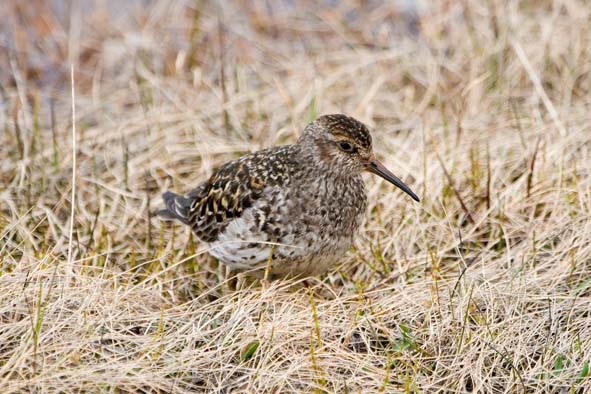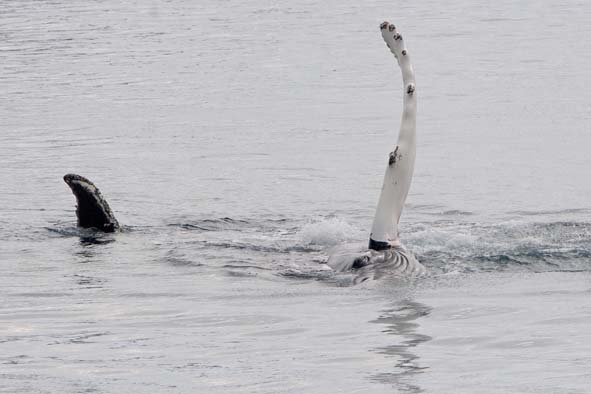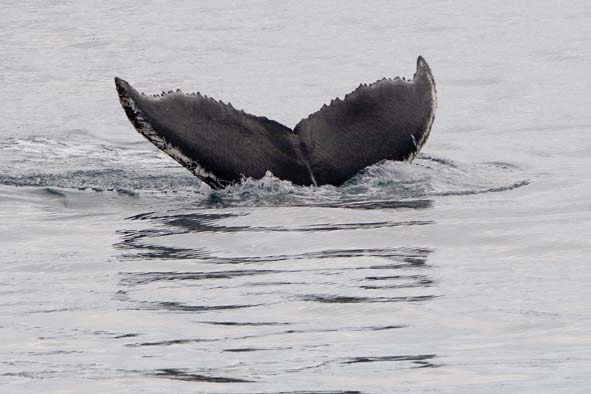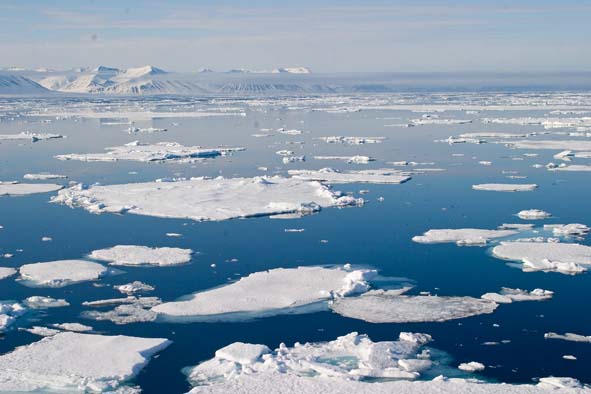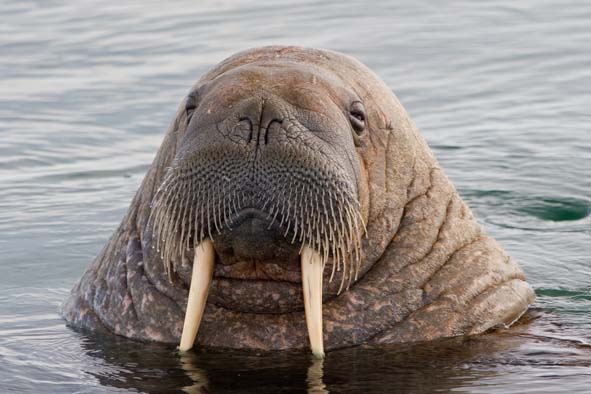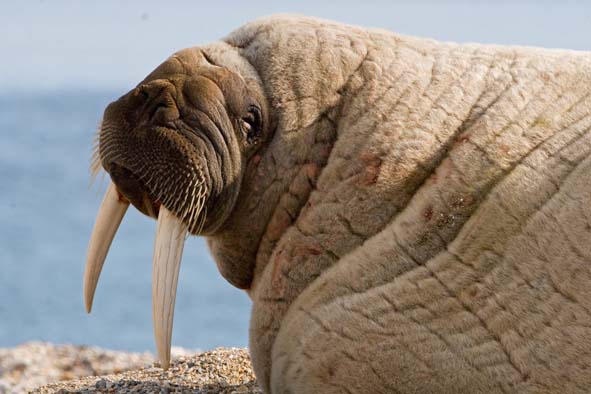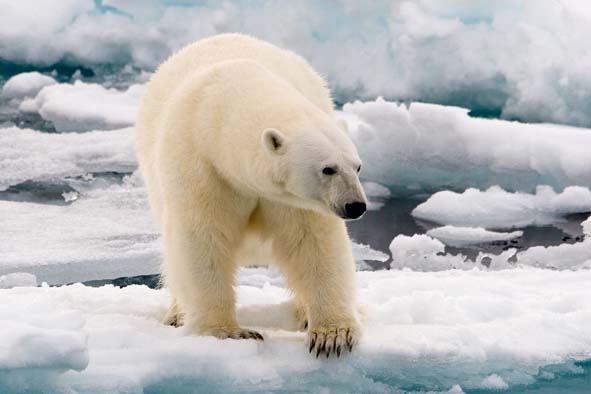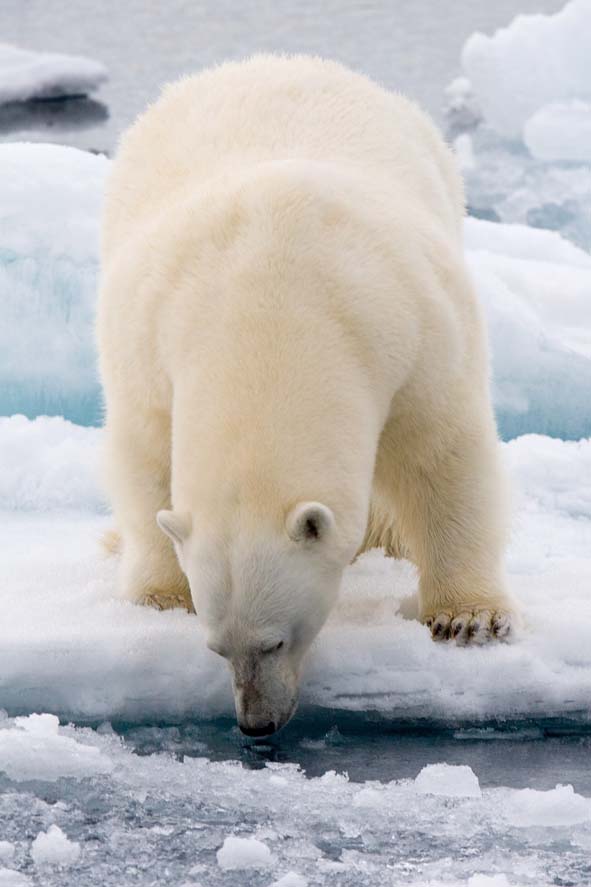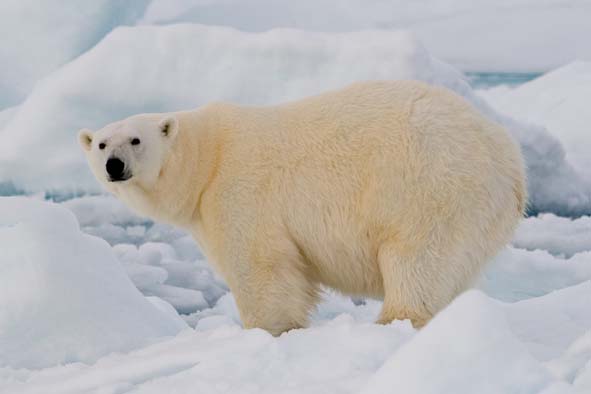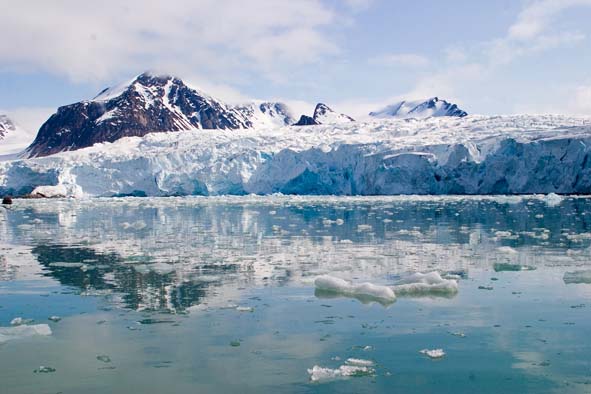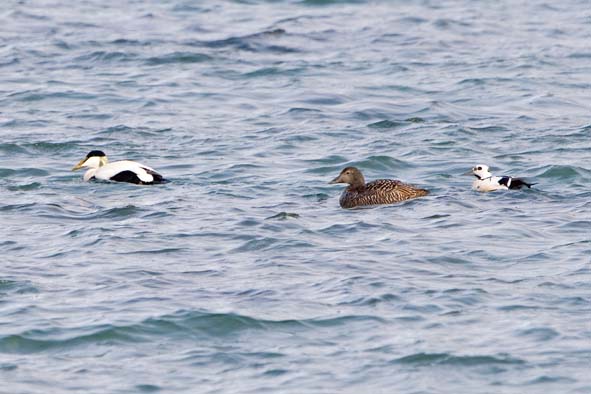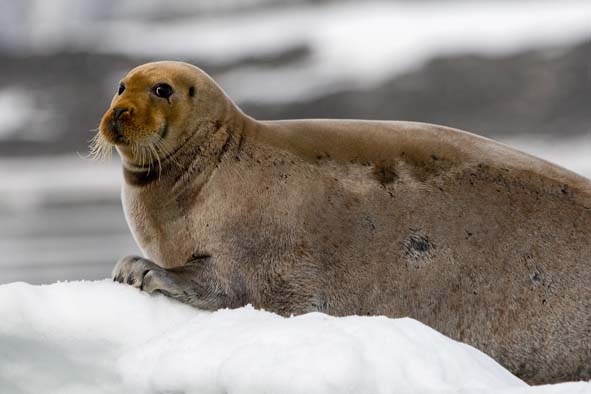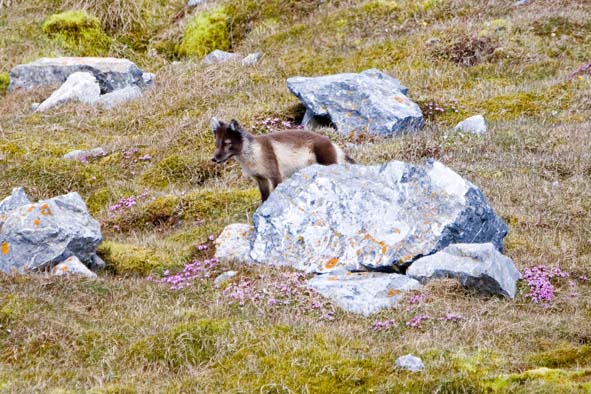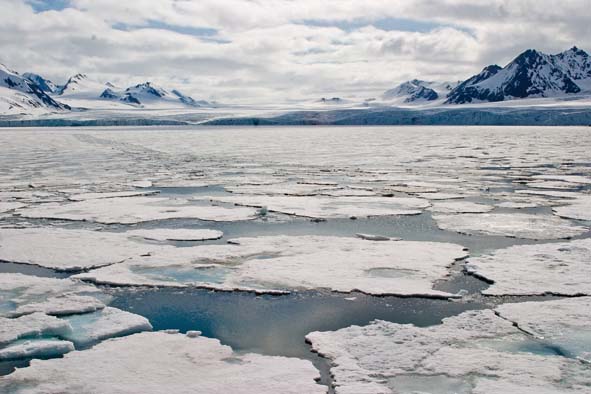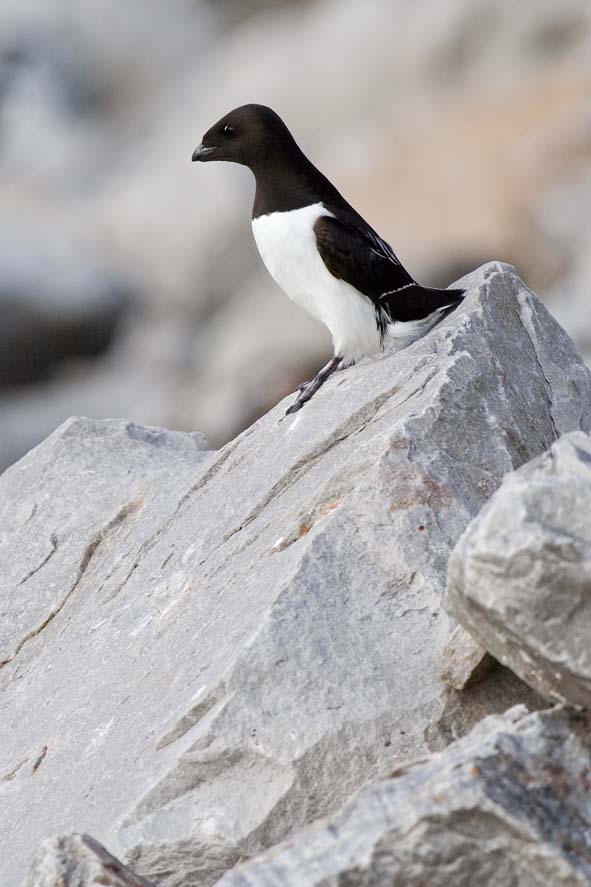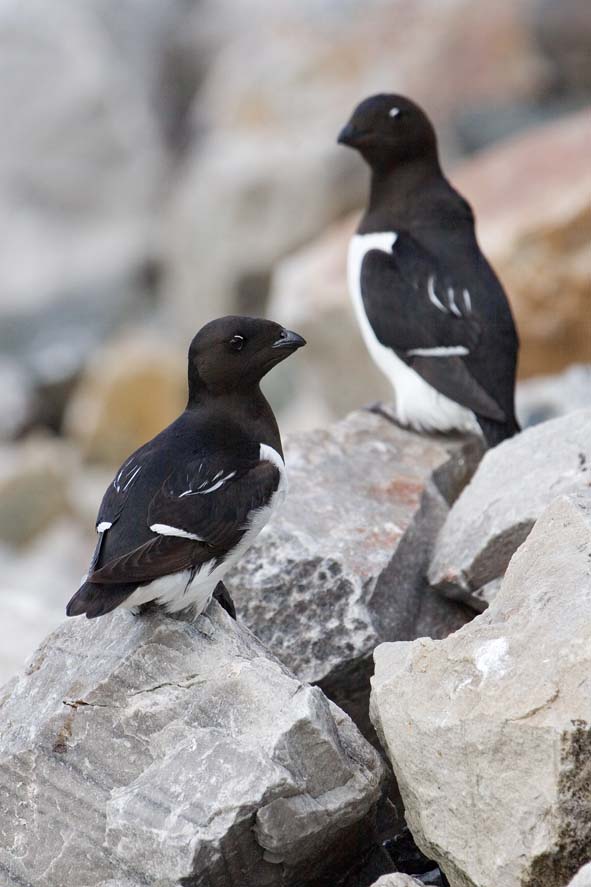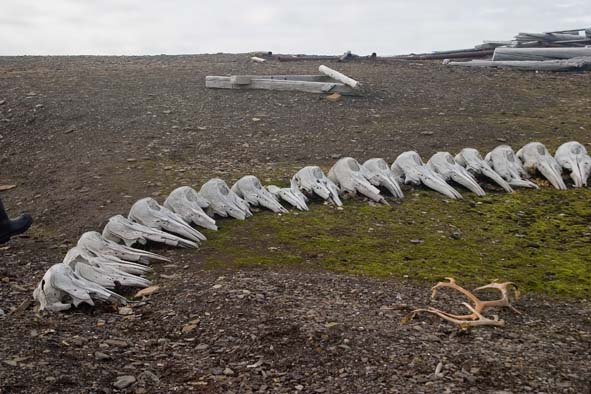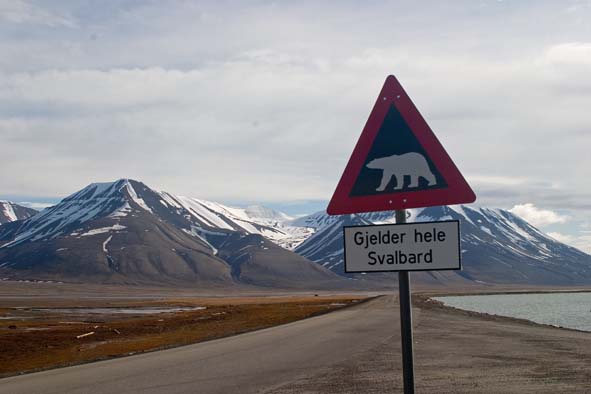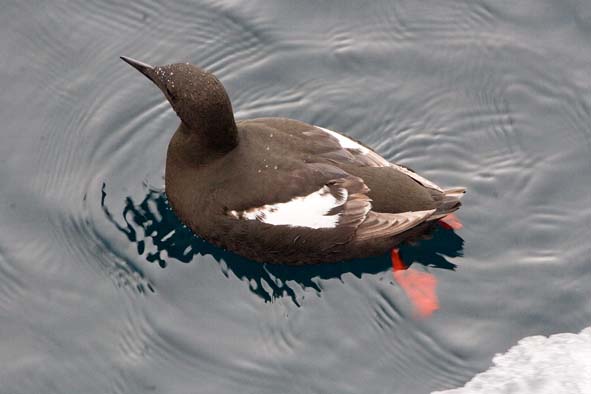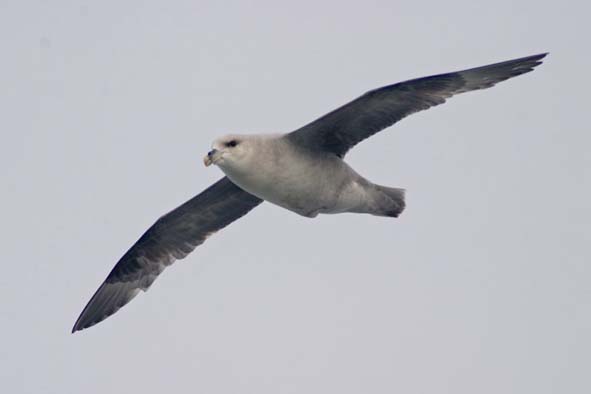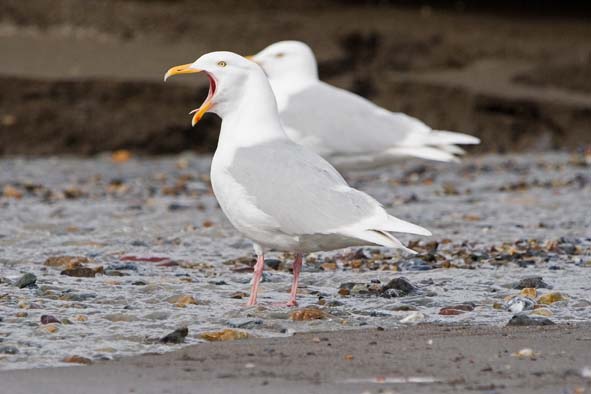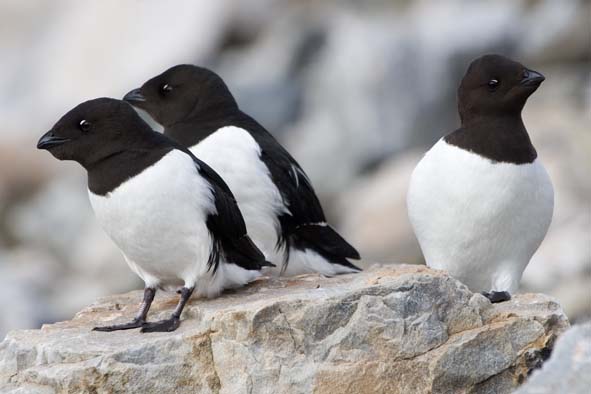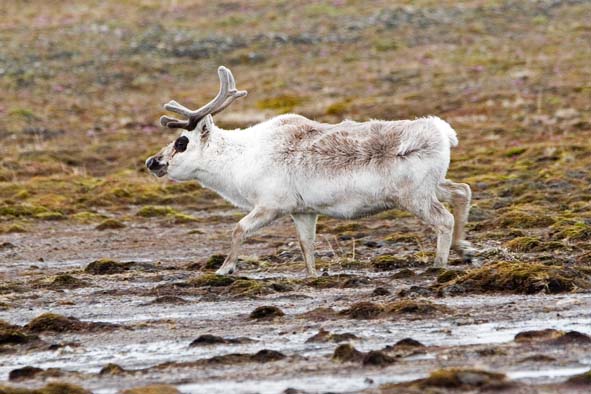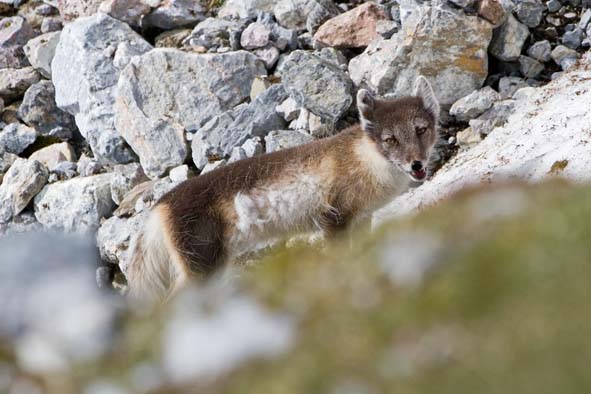CIRCUMNAVIGATION OF SPITZBERGEN 23rd June – 4th July 2009
Introduction
The obvious main target for this trip was Polar Bear. As I live in the UK I knew there would not be many, if any new species of birds seen, but the scenery and mammals would make up for this in abundance.
Logistics
The expedition would be on the Polar Pioneer run by Aurora Expeditions.
The expedition was booked through Alex Mudd and Lara Paxton from Steppes Travel – both were extremely helpful and I couldn’t recommend them highly enough. I booked a triple share room and as it was the first trip of the season was able to get a good discount from the listed price.
Alex helped with suggestions for the flights required to get to Longyearbyen but I did book them direct with the relevant airlines. Outgoing flights were relatively easy and was able to fly from Newcastle to Longyearbyen via Stavanger and Olso with Scandinavian Airlines, but for the return journey I had to fly via Oslo and Heathrow as there was no flight between Stavanger and Newcastle on that day.
On-board

The Polar Pioneer is an excellent little ship (tiny in comparison with some of the huge cruisers seen docked in Longyearbyen) – a 56 passenger converted ice strengthened research vessel – ideal for the job in the high Arctic!! On our expedition there were only 40 tourists on board which meant that my triple shared room was mine alone which made it an even more comfortable trip.
The Guiding staff (Henrik, Gary, Sue and Giles) were excellent, all very friendly and knowledgeable about the Arctic and its wildlife.
The food served by the two Irish Chefs (Mike and Daz) was brilliant, plentiful and quite creative from such a small galley. Hot drinks, biscuits and fruit were available at anytime of the day.
Penny did a great job of running the bar and organising the staff. Beware of Polar Bear Beer (7.5% Danish Lager) – it tastes too good and can cause you to miss zodiac cruises (see below)!!!
Itinerary
22nd June – as we landed in Longyearbyen an Arctic Skua flew off the runway in the midnight sun. Pools just below the airport held Glaucous Gull, Eider, Barnacle and Pink-footed Geese. I caught the bus from the airport to the Spitzbergen Guesthouse (set charge of 50 Krona). En-route to my hotel an Arctic Fox ran across the Tundra behind the town’s school and a Svalbard Reindeer was also seen. I checked in and then went for a quick wander utilising the 24 hour daylight. A couple of hundred Brunnich’s Guillemots were breeding on the cliffs above the Guesthouse and two Svalbard Ptarmigan were seen on the scree below the cliffs.
23rd June – Walked down to the coast of Longyearbyen, seeing another Svalbard Ptarmigan, Purple Sandpiper, Snow Buntings and two Svalbard Reindeer en-route. A female Grey Phalarope was chasing Arctic Terns on the marshy area opposite the main Road. A drake King Eider was on the sea with about thirty Common Eider. Eight Black Guillemots and two Long-tailed Ducks were in the dock.
Just after lunch I met with some of my fellow expeditioners at the Spitzbergen Hotel and got the Aurora organised bus to the Airport to collect the last of the passengers. We then had a tour of the Longyearbyen museum and then was driven about five miles up Adventdalen (Valley heading east from Longyearbyen) to a Seal Hunter’s Station – en-route seeing a beautiful drake King Eider on one of the small roadside pools.
Zodiac’ed out to the boat at 5:30pm – and was on deck as we headed out to Isfjorden, four King Eiders flew passed and the first of many Auks, Fulmars and Kittiwakes were seen.
24th June – During the night we had made our way into Krossfjorden on the West coast of Spitzbergen. After breakfast we took a zodiac cruise along the bird cliffs and the Fjortende Julibreen (14th July Glacier). The auk colony here contained about five hundred Brunnich’s Guillemot and about thirty Puffins plus the odd Black Guillemot, on the higher cliffs there was a colony of about one thousand Kittiwakes. Two Arctic Foxes were seen patrolling the base of the mountain cliffs.
In the afternoon we landed at Ny Alesund – the northernmost settlement in the world and mooring site of Roald Amundsen airship Norge for his successful flight over the North Pole in 1926. We walked out to the mooring mast passing a Svalbard Reindeer and a flock of Barnacle Geese. Just on the outskirt of town was a small Arctic Tern Colony – which proceeded to ‘bomb’ us all. Back down at the dock a Grey Phalarope flew over and a Long-tailed Duck was on a small lake.

Just after setting off from Ny Alesund into Kongsfjorden, a Humpback Whale surfaced and entertained us for about half an hour surfacing and diving showing its tail flukes and then a display of ‘flipper flapping’. An adult Pomarine Skua with full tail spoons flew over the boat.
25th June – as we entered Woodfjorden we were surrounded by good numbers of Little Auks and Brunnich’s Guillemots. Two Walrus were seen distantly on sea ice, as were a small number of Bearded Seals. A very distant Polar Bear was seen walking along the shoreline but we were beaten to it by another tourist group – so no celebrating yet!!!
We then landed on Andoyane (Duck Islands), Liefdefjord and walked out to a Trappers Hut. Nine Grey Phalaropes were seen just off the shore, three Pomarine Skua’s and two Red-throated Divers flew over, five Svalbard Reindeer and five Pale-bellied Brent Geese grazed on the tundra. We then went for a zodiac cruise around the floating ice, another six Grey Phalaropes were seen and two of the zodiac’s had a lucky encounter with a Minke Whale.
We then left Liefdefjord and headed for Moffen Island, seeing our first Ivory Gull and a Minke Whale, which surfaced three times.
Just before Moffen Island we crossed over 80 degrees north. Moffen Island is a protected Nature Reserve and boats aren’t allowed any closer than three hundred away. About forty Walrus were hauled out resting on the island, with another five on a block of sea ice. A Great Skua flew over the island and an adult Sabine’s Gull was seen within a flock of Kittiwake.
26th June – spent all of the morning and some of the early afternoon sailing through sea ice to the West of Nordaustlandet about thirty Ringed Seals were hauled out onto the ice in singles or pairs and quite a few Polar Bear tracks were seen, as were another Ivory Gull and single Pomarine and Long-tailed Skua’s.
In the late afternoon we zodiac’ed out to Sogfjorden (Sorrow Fjord) – an old Whaling station with a number of whalers graves. About ten Purple Sandpipers were along the beach and rocky outcrop. Someone mentioned to me that Gary (our Naturalist Guide) was showing some of the group Polar Bear tracks in the snow, so I looked down at the group with my binoculars (as I was too lazy to walk over!!) and then looked down the beach behind them “POLAR BEAR, POLAR BEAR, REALLY POLAR BEAR”. He was about half a mile away and heading towards us – we had a quick look and then a well organised evacuation ensued. Gary and Henrik, stayed on the mound watching the bear while we crossed the snow to the zodiacs. The bear then entered the water and started swimming across the bay. We zodiac’ed out into the bay but kept a very sensible distance away from the bear so as not to cause it any undue stress. Now it was time to celebrate!!!
Before heading to the bar we managed to see four Sabine’s Gulls flying passed us in the Hinlopenstredet.
Now this is where it goes horribly wrong (well for me and Magnus anyway) – Polar Bear Beer (god was it good at the time though).
27th June – completely missed the wake up call for breakfast and the first zodiac cruise of the day, as did Magnus!!! I was finally woken at about 11 as Henrik announced that everyone had had a lovely cruise around the Brunnich’s Guillemot cliffs of Alkafjellet (I needed Alka seltzer!!) – which meant that two out of the three birders on board actually missed one of the birding highlights!!!!
As we sailed down the Hinlopenstredet another Polar Bear was seen walking across a small red rock island. A Great Skua was on the same island. The bear then walked down the hillside of the island and swam across the small bay.
Our next port of call was Torellneset, at the southern end of Nordaustlandet, where fifteen Walrus were hauled out at the end of a spit. As we got closer to the sleeping group four more swam around the spit and attempted to haul themselves out – giving fantastic views of them swimming. There was also six Svalbard Reindeer here as well as a fly over Red-throated Diver.
Celebrating another great day and another great Polar Bear, a few of us were having a beer or three in the bar when suddenly Suzanne pointed at the window and shouted “POLAR BEAR”.
 Everybody ran outside and then straight to their cabins for the cameras. The bear was on floating ice and before we knew it the Russian Captain and crew had superbly brought us flush with the ice – don’t even think we touched it!!! The bear then walked towards us occasionally sniffing the air for our scents. She walked down to about 20 metres away jumping across any breaks in the ice that were to big to step across. After about half an hour (and about 600 photos later) she started to wander off and so we left her to her little ice island.
Everybody ran outside and then straight to their cabins for the cameras. The bear was on floating ice and before we knew it the Russian Captain and crew had superbly brought us flush with the ice – don’t even think we touched it!!! The bear then walked towards us occasionally sniffing the air for our scents. She walked down to about 20 metres away jumping across any breaks in the ice that were to big to step across. After about half an hour (and about 600 photos later) she started to wander off and so we left her to her little ice island.
28th June – as we travelled back north up the Hinlopenstredet (we had to turn back during the night as there was too much fast ice near to Edgeoya) the main things of note were a Bearded Seal and a Great Skua.
All of the day was spent travelling up the Hinlopstredet and towards the end thick fog enveloped the boat – so ended up being a quite leisurely day.
29th June – as we entered Bjornfjord (Bear Fjord) from Smeerenburgfjorden another Polar Bear was seen on a snowy hillside. He started rolling about in the snow presumably to dry off from a recent swim.
We then went out for a zodiac cruise around the Smeerenburg Glacier, where we were able to watch the glacier calve, causing a small wave and then covering the sea in crush ice. About twenty Black Guillemots and a Bearded Seal were also seen on this cruise.
The Polar Bear was still on the hillside but this time asleep.
Next up was the island Amsterdamoya and the old Dutch whaling station of Smeerenburg. We were welcomed onto the island by a small colony of Arctic Terns. A single Walrus was hauled up on the beach sleeping. As most of the group took a walk along a peninsular I decided to stay around the Walrus and take more pictures – until over the radio Sue announced that Magnus had found a drake Steller’s Eider. I raced down to where the group was and soon picked up my only tick of the trip. A Great Skua flew over and a Bearded Seal was just offshore.
The final visit of the day was to Gravneset in the picturesque Magdalenefjord, this is a site of a 17th century English Whaling Station. High above on the mountain cliff tops about two thousand Little Auks swarmed around there breeding colony.
30th June – zodiac’ed out to Farmhamna and went for a walk on the tundra-type habitat. There were about ten Svalbard Reindeer including a cracking male that kept giving the photographers the run around. Two flocks of geese were seen, seven Pink-feet and eighteen Barnacles. A nice male Grey Phalarope was found on a small pool with a male Snow Bunting along the pool edge.
Next was St Jonsfjord and a sedate (well for some of us) walk round looking at the flowering plants. Two Arctic Skua’s were using two small hillocks as vantagepoints. Two Purple Sandpipers and a Ringed Plover were along the beach and three Ringed Seals were swimming just off shoreline. We then went looking for two seals that had been spotted from a Mountain Ridge. As we approached one of the two Bearded Seals slid from the sea ice into the water and then spent about ten minutes swimming around before hauling himself back onto the sea ice.

1st July – We awoke in the large fjord of Hornsund, on the south western side of Spitzbergen. Straight after breakfast we headed out to Sofiabogen, a large breeding colony of Auks and Kittiwakes, the view from here over Burgerbutka were absolutely stunning. A pair of Glaucous Gulls were nesting on top of a rock outcrop with the single chick visible in the nest. The highlight here was an egg-carrying Arctic Fox which ran through the group (only a couple of metres away) and then proceeded to bury the egg in a bank of snow. Presumably the same fox was seen later on following Bruce and Gary along a snow bank, the fox stopping and starring every time they turned round.
We then tried approaching Samarinbreen Glacier but 4km of fast ice put steed to that, although there were quite a few Ringed and Bearded Seals distantly on the ice.
A cruise around Muhlbacher Glacier was to be our last zodiac outing of the day. Again this Glacier was seen to calve on a couple of the occasions, and the agitation that this caused seemed to attract lots of Kittiwakes, Fulmars and good number of Black Guillemots as well as a flock of twenty five Glaucous Gulls.
The day ended with a superb BBQ on the stern of the boat – with special guests Black Guillemots and Fulmars just off the boat.
2nd July – Our last full day on the boat we arrived at Varsolbukta in Bellsund. This was to be one of the main highlights of the trip for me, as the scree slopes here was the breeding site of thousands of Little Auks.  Before we reached the scree we had already seen eight Svalbard Reindeers and fifteen Barnacle Geese. Up on the scree slopes we were able to sit down on the slope within about twenty five feet of the nesting Auks.
Before we reached the scree we had already seen eight Svalbard Reindeers and fifteen Barnacle Geese. Up on the scree slopes we were able to sit down on the slope within about twenty five feet of the nesting Auks.
As we approached our last landing site, Bamsebu, someone spotted a distant Polar Bear walking along a beach of one of the islands, this was to be our sixth and final Polar Bear sigthing.
Bamsebu is the site of an Old Norwegian Beluga Whaling Stations, and the beach is ‘littered’ with hundreds of bones from these amazing creatures – sadly we weren’t to see the real living item. There wasn’t much seen at this site other than six Svalbard Reindeer and a pair of Snow Buntings which were possibly nesting in the lookout platform.
On the return journey to Longyearbyen in the evening a final Walrus was seen swimming in front of the boat just before we entered Isfjorden. The night was spent travelling up Isfjorden before dropping anchor just outside Longyearbyen.
3rd July – After zodiac’ing off the boat at around 8:30am and then saying our goodbyes to everyone we’d met on the voyage the rest of the day was spent birdwatching around the town and airport. Firstly we went down to the dog cages about 1 km away from the town centre, there were about sixty breeding Eiders on the small pools next to the kennels and three Arctic Skuas flying around. On the saltmarsh opposite there were quite a few Purple Sandpipers, single Dunlin and Ivory Gull. Two more Ivory Gulls and a nice male Long-tailed Duck were on the large lake next to the roadside. A nice male Svalbard Reindeer was along the roadside on the way back into town. We then headed upto the Airport where the Arctic Terns, Glaucous Gulls and Barnacle Geese were showing, as well as a flock of ten (nine males and a female) King Eider on the pools below the airport. Three more female King Eiders were then found on the same pool. A pair of Long-tailed Ducks and a Ringed Plover were on the smaller pools. On returning to the Spitzbergen Guesthouse another Svalbard Ptarmigan was found on the scree slope.
4th July – arrived at the Airport for the 4:55 am flight to Oslo. A quick scan over the pools produced the usual Terns, Gulls and Geese.
Species Seen:-
Birds:-
Red-throated Diver Gavia stellata – two flew over Woodfjorden and two over Moffen Island on the 25th June.
Northern Fulmar Fulmarus glacialis – abundant.
Barnacle Goose Branta leucopsis – common.
Pale-bellied Brent Goose Branta hrota – five at Woodfjorden and two at Moffen Island on the 25th June.
Pink-footed Goose Anser brachyrhynchus – quite common.
Long-tailed Duck Clangula hyemalis – quite common around Longyearbyen. Single male at Ny Alesund on the 24th June and a pair at Woodfjorden on the 25th.
Steller’s Eider Polysticta stelleri – one drake with a small group of Eiders at Smeerenburg, Amsterdam Island on the 29th June.
Common Eider Somateria mollissima – very common.
King Eider Somateria spectabilis – small numbers around Longyearbyen, with two drakes seen on the 23rd June, four in Isfjorden on the 23rd June and 13 on the pools below the Airport on the 3rd July.
Turnstone Arenaria interpres – one male flew over the pack in North Western Spitzbergen on the 25th June.
Common Ringed Plover Charadrius hiaticula – two near the dog cages at Longyearbyen on the 23rd June, one Ny Alesund on the 24th, one at St John’s Fjord on the 30th and one at Longyearbyen Airport on the 3rd July.
Purple Sandpiper Calidris maritime – relatively common.
Dunlin Calidris alpina – one near the Dog Kennels at Longyearbyen on the 3rd July.
Grey Phalarope Phalaropus fulicaria – singles seen in Longyearbyen (23rd June), Ny Alesund (24th) and Farmhamna (30th), with fifteen in Woodfjorden on the 25th June.
Glaucous Gull Larus hyperboreus – very common.
Ivory Gull Pagophila eburnean – singles seen en-route to Moffen Island on the 25th June, Liefdefjorden and in the pack-ice, North Eastern Spitzbergen on the 26th. Three were seen at the Dog Kennels at Longyearbyen on the 3rd July.
Sabine’s Gull Xema sabini – one at Moffen Island on the 25th June and four in the Hinlopenstredet on the 26th.
Kittiwake Rissa tridactyla – abundant.

Arctic Tern Sterna paradisaea – very common.
Arctic Skua Stercorarius parasiticus – common.
Long-tailed Skua Stercorarius longicaudus – one in the Hinlopenstredet on the 26th June.
Pomarine Skua Stercorarius pomarinus – one in Kongsfjorden just off Ny Alesund on the 24th June. Three over Woodfjorden on the 25th and one in pack-ice, North Eastern Spitzbergen on the 26th.
Great Skua Stercorarius skua – singles seen at Moffen Island on the 25th June, Northern Hinlopenstredet on 27th, Hinlopenstredet on 28th, Magdalenafjorden and Smeerenburg, Amsterdam Island on 29th.
Black Guillemot Cepphus grylle – very common.

Brunnich’s Guillemot Uria lomvia – abundant.
Common Guillemot Uria aalge – two auks in Isfjorden on the 23rd were possibly this species.
Little Auk Alle alle – abundant. Especially at colonies of Magdalenafjorden on 29th June (c2000) and Varsolbugta, Bellsund on 2nd July (c10000).
Atlantic Puffin Fratercula arctica – small numbers seen from the boat. About 30 in small colony near Fjortende Julibreen on the 24th June.
Svalbard Ptarmigan Lagopus mutus – two seen on scree slopes behing Spitzbergen Guesthouse, Longyearbyen on the 22nd, with singles seen here on the 23rd June and 3rd July. No sites for this species were accessible during the expedition.
Snow Bunting Plectrophenax nivalis – common in Longyearbyen and relatively common at sites visited during the expedition.
Mammals:-
Minke Whale Balaenoptera acutorostrata – one seen surfacing three times en-route to Moffen Island on the 25th June.
Humpback Whale Megaptera novaeangliae – one showed superbly in Kongsfjorden as we left Ny Alesund on the 25th June.
Arctic Fox Vulpes lagopus – one seen behind the school in Longyearbyen on the 22nd, two at Fjortende Julibreen on the 24th and one at Sofiebogen, Hornsund on the 1st July.
Polar Bear Ursus maritimus – total of six seen. One distantly on the shoreline of Woodfjorden on the 25th June. One on the beach at Sogfjorden (Bay of Sorrows) on 26th which caused us to evacuate to the zodiac’s (although still about half a mile away). One walking across a red rock island in the northern Hinlopenstredet on the 27th. Another, cracking female, on an ice flow in the mid Hinlopenstredet again on the 27th at about 11:15 pm – showed down to about 20 metres. One walking up snowy hillside in Smeerenburgfjorden on the 29th, it then started rolling in the snow to dry off. And a final distant one on an island off Bamsebu, Bellsund on the 2nd July.

Walrus Odobenus rosmarus – two on pack-ice in Liefdefjorden and about 45 at Moffen Island on the 25th June. Nineteen on Torellneset, Nordaustlandet on the 27th. One hauled out on beach on Amsterdam Island, Smeerenburg on the 29th. And one swam across the ships bow as we were entering Isforden on the 2nd July.

Bearded Seal Erignathus barbatus – singles or small numbers seen at a number of locations.
Ringed Seal Pusa hispida – singles or small numbers seen at a number of locations, with about thirty being seen in the Pack-ice of North Eastern Spitzbergen on the 26th.
Svalbard Reindeer Rangifer tarandus platyrhynchus – quite common and seen at a number of locations including a couple in Longyearbyen and one at the Airport.


